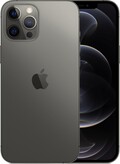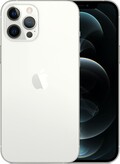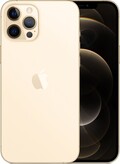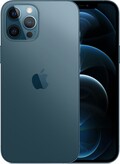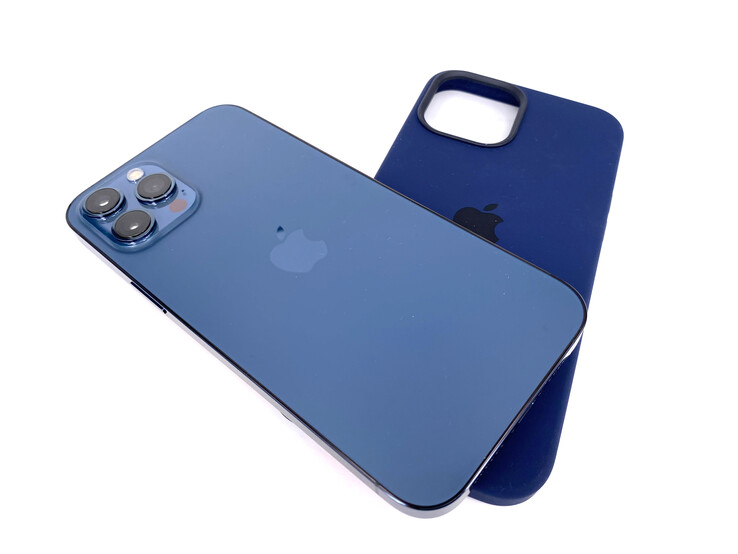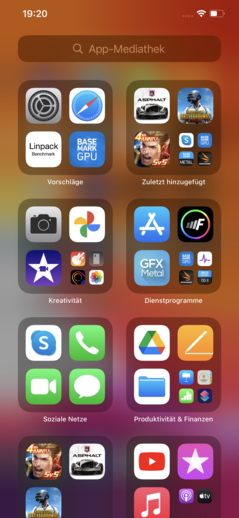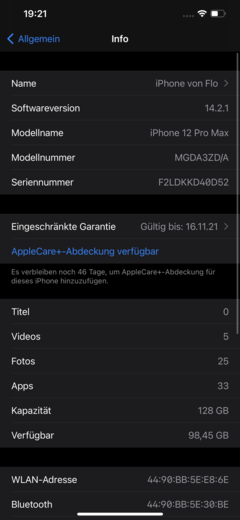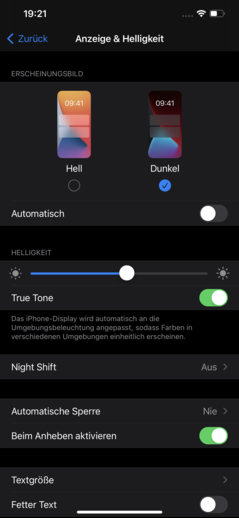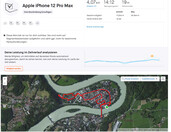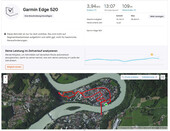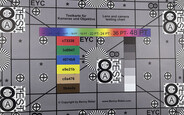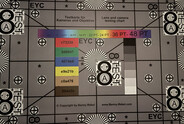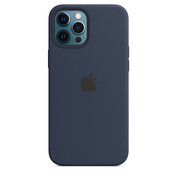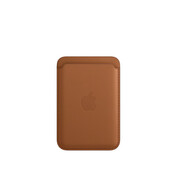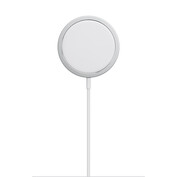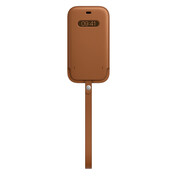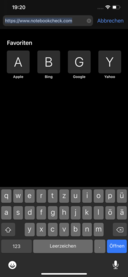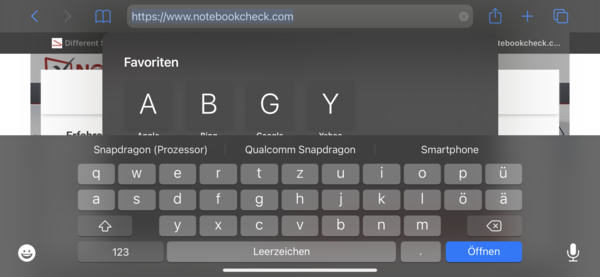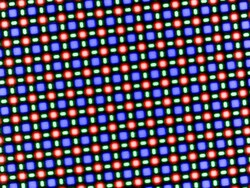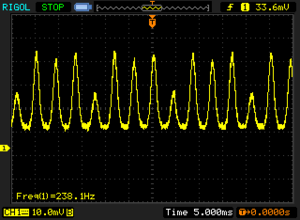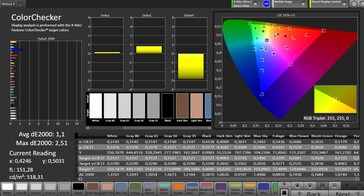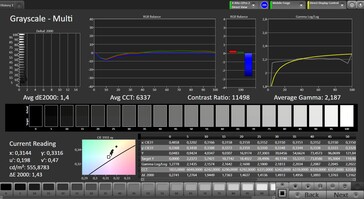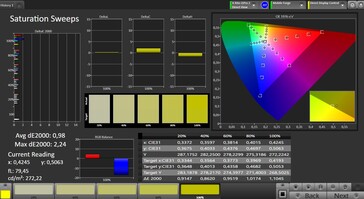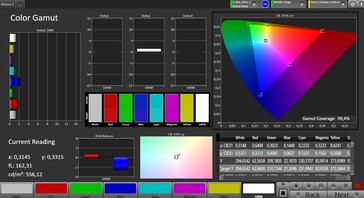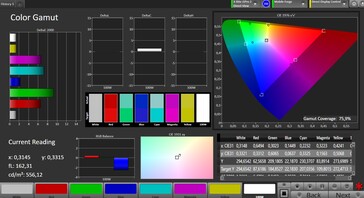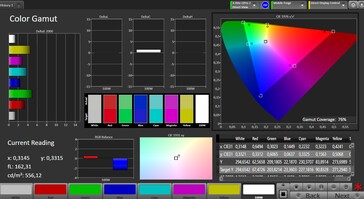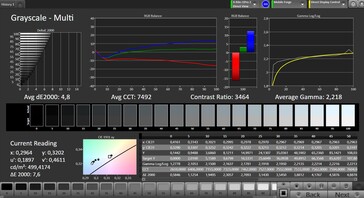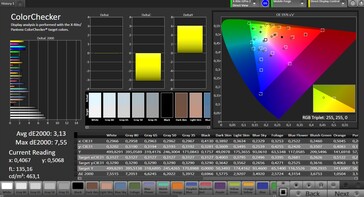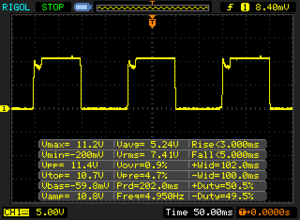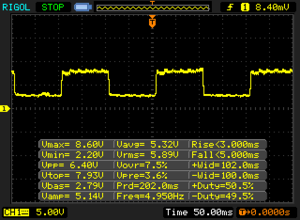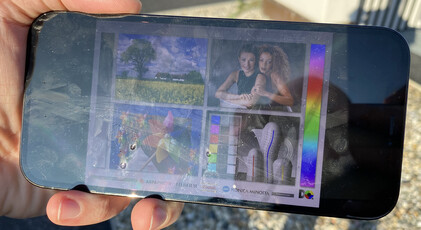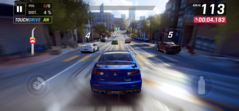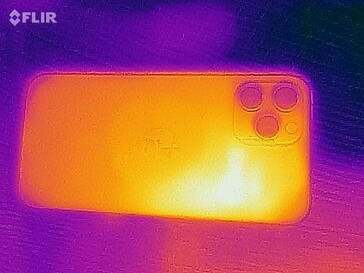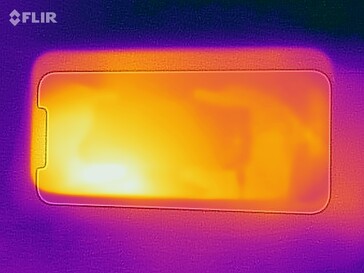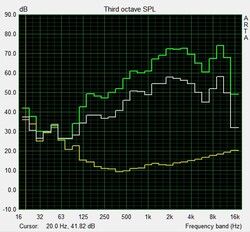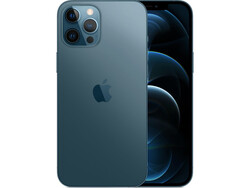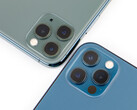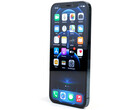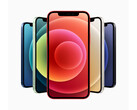Apple iPhone 12 Pro Max Smartphone Review – Large High-End Apple Phone
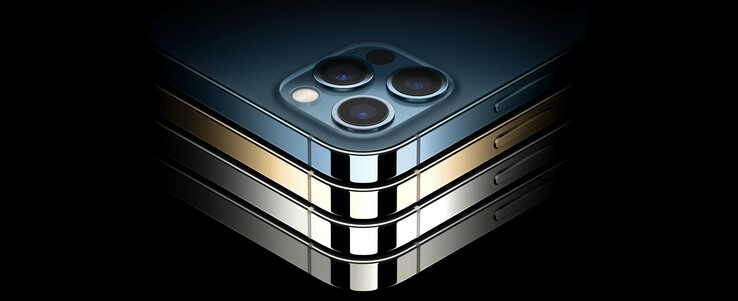
The iPhone 12 Pro Max is the most expensive and largest device in Apple’s 2020 iPhone line-up. Like the other models it, too, features the new design language, and has received various improvements as well as a storage upgrade while starting at the same price as last year. With the launch of this model, the iPhone 11 Pro Max has been officially discontinued.
Prices can go up to $1,399 for the highest storage-tier model, and AppleCare+ adds another $199 adding up to a total of $1,599. That is a lot of money for a smartphone, but with a LiDAR sensor for nighttime photography and AR applications, the new MagSafe connector, Apple’s own RAW and HDR formats, and support for fast 5G connectivity there are quite a few benefits for professionals thrown in.
Let’s take a closer look at the smartphone in order to find out whom this most expensive iPhone is really made for.
Potential competitors in comparison
Rating | Date | Model | Weight | Drive | Size | Resolution | Price |
|---|---|---|---|---|---|---|---|
| 88.7 % v7 (old) | 12 / 2020 | Apple iPhone 12 Pro Max A14, A14 Bionic GPU | 228 g | 128 GB NVMe | 6.70" | 2778x1284 | |
| 87.1 % v7 (old) | 09 / 2019 | Apple iPhone 11 Pro Max A13 Bionic, A13 Bionic GPU | 226 g | 64 GB SSD | 6.50" | 2688x1242 | |
| 89.3 % v7 (old) | 07 / 2020 | Huawei P40 Pro Plus Kirin 990 5G, Mali-G76 MP16 | 226 g | 512 GB UFS 3.0 Flash | 6.58" | 2640x1200 | |
| 89.6 % v7 (old) | 02 / 2021 | Samsung Galaxy Note20 Ultra Exynos 990, Mali-G77 MP11 | 208 g | 256 GB UFS 3.1 Flash | 6.90" | 3088x1440 | |
| 85 % v7 (old) | 09 / 2020 | Sony Xperia 1 II SD 865, Adreno 650 | 181.4 g | 256 GB UFS 3.0 Flash | 6.50" | 3840x1644 | |
| 88.2 % v7 (old) | 04 / 2020 | Xiaomi Mi 10 Pro SD 865, Adreno 650 | 208 g | 256 GB UFS 3.0 Flash | 6.67" | 2340x1080 |
Case – Great Quality, but Delicate
The camera module and the large notch at the top of the display are the most prominent similarities to its own predecessor, the iPhone 11 Pro Max. Apart from that Apple’s new design language is a return to iPhone models of yore, and the new devices feature sharp and squared edges. In our humble opinion this renders the devices even more premium and unique than the rounded edges of previous generations.
As always, Apple’s Pro models come in a rather discreet selection of colors. This year’s color selections include Graphite, Silver, Gold, and Pacific Blue. The iPhone 12 Pro Max’s is ever so slightly taller than its predecessor but also ever so slightly narrower in return. At 228 g the smartphone remains a fairly heavy contender and continues to require rather large hands to be used comfortable due to its width.
At the front we find Apple’s own “Ceramic Shield” ceramic glass covering the display. Drop tests performed on the internet showed that it is indeed surprisingly strong on the smaller iPhone models. However, the larger iPhone 12 Pro Max still requires a protective case with a protruding bezel around the display because its glass will break much more easily. The same is true for the glass at the rear, which will require replacing the entire case should it shatter.
Considering the great visual impression the combination of matte rear glass and shiny metal frame make it is truly a shame to hide the iPhone 12 Pro Max in a protective case, but it is without a doubt highly recommended nevertheless.
Just like last year this year’s case is waterproof. In addition, Apple releases an environmental report for every one of its products allowing customers to get a glance at the true environmental impact for each and every device. In case of the iPhone 12 Pro Max Apple claims to use 98 % recycled rare earth elements as well as other recycled material and claims to avoid using various potentially harmful substances.
Connectivity – Same Price as Last Year
The good news this year is that customers get more storage at the same price as before, at least when opting for the lowest storage tier entry-level model. The following storage tiers are available:
- iPhone 12 Pro Max with 128 GB storage: $1,099
- iPhone 12 Pro Max with 256 GB storage: $1,199
- iPhone 12 Pro Max with 512 GB storage: $1,399
All SKUs are equipped with 6 GB of RAM. While this may seem fairly low compared to various Android competitors previous Apple smartphones have never exhibited any performance deficits whatsoever because of it.
All 2020 smartphones from Cupertino come with a Nano SIM slot as well as an integrated eSIM, both of which can be used simultaneously.
A new feature is the magnetic ring at the rear referred to as MagSafe. It connects to various accessories and supports charging.
Software – iOS 14 with Enhanced Privacy
iOS 14 contains a variety of new features and supports iPhones as far back as the more than 5-year-old 6S. Thus, you can rest assured that the iPhone 12 Pro Max will continue to be receive security and software updates for many years to come.
New features include app management. For example, you can now prohibit apps from permanently accessing your location or restrict apps to access only certain selected photos instead of your entire photo library. If you only need specific widgets at specific times of the day, for example while at work, you can rotate and swap them out automatically. The App Library groups apps automatically and gives you an improved overview over all of your installed applications.
Preloaded third-party software applications are traditionally not a thing on Apple smartphones, and this year’s devices are no different. Instead, the devices come with various Apple in-house apps preloaded, such as Apple’s own office suite, iMovie to edit movies, or GarageBand to create and edit your own audio tracks.
Communication and GPS – Now with 5G
For the first time ever Apple’s iPhones support fast 5G connectivity. Unfortunately, the extremely fast mmWave technology is not available on European iPhone models and thus far limited to devices sold in the US and Canada. This may not be a huge deal right now due to the lack of mmWave-compatible European 5G networks but can become an issue for those who travel frequently.
Apple does not specify its LTE modem’s maximum transfer rates but only states that it supports 4x4 MIMI Gigabit LTE, which should be much faster than most currently available LTE networks are capable of delivering. In our tests, the iPhone 12 Pro Max’s connectivity was very good, and it often showed 3/4 or even all bars inside buildings. Other smartphones perform at a similar level but some, such as the OnePlus 8 Pro, only reached half that under similar circumstances.
Wi-Fi 6 is supported as well, and the iPhone 12 Pro Max does a better job than its predecessor albeit with some issues when receiving data. When connected to our Netgear Nighthawk AX12 reference router the data rate fluctuated immensely and was only good enough for last place and similar to that of the iPhone 11 Pro Max. Granted, 575 Mbps are anything but slow and more than fast enough for most networks but it has to be noted that other premium smartphones perform much better in this test and offer much higher Wi-Fi speeds. All was hunky-dory when transmitting data though, and the iPhone 12 Pro Max secured a place somewhere in the middle of the pack.
Supported GNSS services include GPS, Glonass, BeiDou, QZSS, and Galileo. The device also comes with a digital compass as well as barometer for determining altitude based on ambient air pressure.
Just like every device we test the iPhone 12 Pro Max had to prove itself on our outdoor bicycle tour around the block where we compared its GPS tracking accuracy with that of a professional Garmin Edge 520 satnav. All things considered the iPhone performed very well, and its location accuracy was very high even under rather difficult circumstances. We noticed only minor dropouts, and the iPhone placed us on the wrong side of the road when crossing the bridge, but overall accuracy was so good that the iPhone 12 Pro Max is highly recommended when and if exact and accurate GPS data is required.
Telephony and Call Quality – Not Very Clear
Apple’s telephony app features four tabs for direct access to contacts, favorites, recents, and a dial pad. Calls from third-party applications such as Skype show up in that recents list as well, and the app will always open up with the tab that was active when it was last closed. If, for example, you are using the favorites tab most often then that is what you will see most of the time when launching the app.
Call quality on earphone was okay, however our conversational partner was not always very clear at maximum volume, and we found voices to be slightly dampened with a minor hum. Quality improved noticeably when lowering the volume, but voices remained slightly distant, nevertheless. Our own voice was recorded very well by the iPhone’s microphones regardless of whether we were speaking loudly or quietly. The overall soundscape was similar on speakerphone, and the microphones continued to perform at a high level.
Cameras – Larger Sensor and Space Technology
When compared to its predecessor, the iPhone 12 Pro Max’s camera updates seem fairly minor at first glance. It continues to feature three 12 MP lenses at the rear. The main camera’s aperture was increased for improved light sensitivity, and a LiDAR sensor was added to the triple-camera array for improved portrait mode photos in low-light situations. The night mode is now available for the ultra-wide angle lens as well, and the telephoto lens’s aperture is lower than on the iPhone 12 Pro.
The iPhone 12 Pro Max’s main camera continues to create extremely detailed well-exposed photos, even when zoomed in. When subjected to low-light situations with a single light source creating a high contrast between light and dark areas the iPhone continued to create well-exposed photos with a high level of details even in the dark areas. The wide-angle lens takes photos with a high dynamic range, but its photos were not as sharp as the main camera’s when zoomed in.
Videos are recorded in 4K at 60 FPS, and a hybrid zoom between the wide-angle and the main camera is supported in various small steps even while recording. Apple also promises the ability to use the telephoto lens for zoom. However, this feature is only available in situations with a decent amount of light available. Even in rooms with average lightning the phone reverted to the more light-sensitive main camera and used a digital zoom instead.
There is one feature exclusive to the iPhone 12 Pro Max. Its new optical image stabilizer no longer stabilizes the lens but rather the sensor through an array of magnets allowing for up to 5,000 adjustments per second compared to just 1,000 adjustments for the older system. However, we were unable to notice any differences between the iPhone 11 Pro Max with the lens-mounted OIS and the iPhone 12 Pro Max with its new sensor-mounted OIS, neither when taking photos nor videos with shaky hands. In both cases optical image stabilization worked very well, and the image remained smooth as long as you do not shake too much. The only way to tell that the stabilizer had to make adjustments is via a minor flicker in the light when recording videos.
The front-facing camera features a 12 MP sensor. It takes well-exposed selfies with high focus and supports background blurring via portrait mode. This worked very well and looked very natural despite having to resort to software-enabled background blurring. A night mode can improve photos taken in low-light situations noticeably. Portraits taken in low light benefit from the main camera’s LiDAR sensor and turn out pretty well overall. However, the iPhone 12 Pro Max cannot operate in complete darkness and requires a minimum of light in order to take photos.
Apple’s default camera app lacks most features and settings professionals would love to see. Instead, it is geared much more towards automatic image improvements allowing everybody to take good photos. You can find a great selection of professional camera apps in the app store that will allow you to set parameters such as shutter speed manually.
Image comparison
Choose a scene and navigate within the first image. One click changes the position on touchscreens. One click on the zoomed-in image opens the original in a new window. The first image shows the scaled photograph of the test device.
Hauptobjektiv BlumeHauptobjektiv UmgebungHauptobjektiv Low LightUltraweitwinkelWhen subjected to normalized conditions in our lab the camera took very sharp photos with only very minor loss of focus towards the edges. Colors are slightly distorted, sometimes a bit too dark, sometimes a bit too light (e.g. blacks).
With very little light available the iPhone 12 Pro Max managed to take a well recognizable photo with an acceptable level of grain in the details.
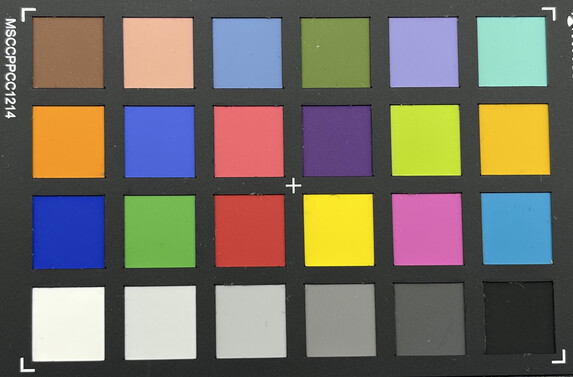
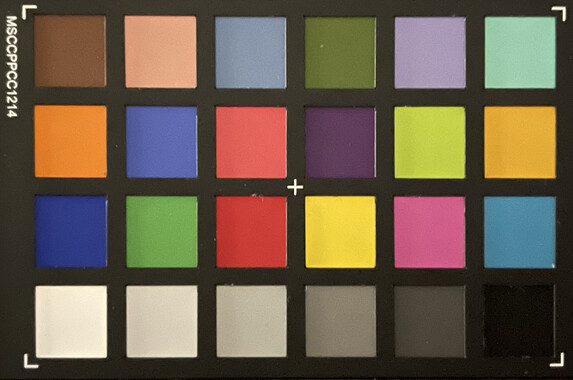
Accessories and Warranty – Charger Not Included
Starting with this year’s generation Apple no longer includes a charger or a headset with their iPhones. According to Apple, these steps were taken purely for environmental reasons. After all, most users will already own a matching 20-Watt power supply. Truth be told we find this rather doubtful. First of all, Apple only started including the fast charger with its previous generation of iPhones, and devices before that had to make do with the slow 5 W charger. In addition, Apple could have passed on the savings resulting from the smaller package and the missing power supply to its customers and lowered the iPhone’s price by $20, which just so happens to be the premium Apple charges for aforementioned 20 W charger.
Alas, the only things we find in the box in addition to the phone and the usual paperwork are a USB-C to Lightning cable as well as a SIM tool. By default, all Apple devices come with a 1-year limited manufacturer warranty. Keep in mind that EU customers get to enjoy a total of 24 months of limited seller warranty. However, after six months the burden of proof that the defect existed when the device was purchased lays upon the user. An additional $199 will get you two years of AppleCare+, including accidental damage protection at a per-case fee.
Without a doubt, the highlight for third-party accessory companies is Apple’s new MagSafe connector. It is even strong enough to safely secure the iPhone 12 Pro Max in car mounts without the help of plastic brackets along the sides. At the time of writing MagSafe accessories were few and far between and limited to protective cases, a MagSafe charger, and a small magnetic wallet that attaches to the back of the phone. However, we expect a huge variety of additional third-party accessories to become available in the near future.
Input Devices & Handling – Very Accurate Handling
The iPhone 12 Pro Max’s touchscreen was very quick to react, responsive, and very accurate. Hardware buttons are located on both sides of the device. They are clearly palpable and easy to use. In addition, a hardware slider on the left-hand side serves as the iPhone’s traditional hardware mute switch.
The fact that the display only supports 60 Hz impacts usability insofar as the system’s responsiveness suffers slightly and is therefore subjectively slower than on systems with high refresh rate displays.
Biometric security features include Apple’s Face ID technology, an infrared-supported face detection feature using the front-facing camera. It is very accurate and works in the dark, and thus both tamper-proof and reliable.
Display – Fine Details and HDR
Apple’s displays traditionally lag behind their competitors in regard to resolution. Keep in mind though that their displays are also slightly longer. Native 4K is not supported, but in turn is not really a thing on other high-end smartphones either and would probably not make a whole lot of sense on a display this small. By and large the Super Retina XDR display is very detailed and supports HDR.
According to Apple’s specifications, the iPhone 12 Pro Max’s display should peak at 800 nits, which was exceeded by a significant margin in our tests. Numbers were even higher when measuring only a small area on the display, as is common for HDR content.
Overall brightness distribution as fairly even and balanced, and colors were pretty accurate. Keep in mind that you may want to disable TrueTone should you require utmost display color accuracy as Apple’s ambient light-based color adjustment feature can distort colors quite a bit.
| |||||||||||||||||||||||||
Brightness Distribution: 98 %
Center on Battery: 855 cd/m²
Contrast: ∞:1 (Black: 0 cd/m²)
ΔE ColorChecker Calman: 1.1 | ∀{0.5-29.43 Ø4.78}
ΔE Greyscale Calman: 1.4 | ∀{0.09-98 Ø5}
99.4% sRGB (Calman 2D)
Gamma: 2.187
CCT: 6337 K
| Apple iPhone 12 Pro Max OLED, 2778x1284, 6.7" | Apple iPhone 11 Pro Max OLED, 2688x1242, 6.5" | Huawei P40 Pro Plus OLED, 2640x1200, 6.6" | Samsung Galaxy Note20 Ultra Dynamic AMOLED, 3088x1440, 6.9" | Sony Xperia 1 II OLED, 3840x1644, 6.5" | Xiaomi Mi 10 Pro Super AMOLED, 2340x1080, 6.7" | |
|---|---|---|---|---|---|---|
| Screen | -19% | -30% | -116% | -114% | 4% | |
| Brightness middle (cd/m²) | 855 | 790 -8% | 672 -21% | 860 1% | 557 -35% | 753 -12% |
| Brightness (cd/m²) | 857 | 790 -8% | 672 -22% | 878 2% | 561 -35% | 762 -11% |
| Brightness Distribution (%) | 98 | 97 -1% | 95 -3% | 96 -2% | 94 -4% | 96 -2% |
| Black Level * (cd/m²) | ||||||
| Colorchecker dE 2000 * | 1.1 | 1.4 -27% | 1.5 -36% | 4.5 -309% | 2.86 -160% | 0.9 18% |
| Colorchecker dE 2000 max. * | 2.51 | 3.4 -35% | 3.2 -27% | 10.4 -314% | 7.29 -190% | 1.6 36% |
| Greyscale dE 2000 * | 1.4 | 1.9 -36% | 2.4 -71% | 2.4 -71% | 5 -257% | 1.5 -7% |
| Gamma | 2.187 101% | 2.23 99% | 2.25 98% | 2 110% | 2.171 101% | 2.24 98% |
| CCT | 6337 103% | 6466 101% | 6250 104% | 6466 101% | 6993 93% | 6415 101% |
* ... smaller is better
Screen Flickering / PWM (Pulse-Width Modulation)
| Screen flickering / PWM detected | 238 Hz | ||
The display backlight flickers at 238 Hz (worst case, e.g., utilizing PWM) . The frequency of 238 Hz is relatively low, so sensitive users will likely notice flickering and experience eyestrain at the stated brightness setting and below. In comparison: 53 % of all tested devices do not use PWM to dim the display. If PWM was detected, an average of 8111 (minimum: 5 - maximum: 343500) Hz was measured. | |||
Given that Apple’s smartphone display is based on OLED technology PWM is almost impossible to avoid. We found an average PWM frequency of 238 Hz, and PWM was always present as soon as display brightness was dimmed. We would thus advise users sensitive to display flicker to closely inspect the iPhone 12 Pro Max’s display before making any purchasing decisions.
Given that the iPhone 12 Pro Max’s display’s refresh rate is just 60 Hz animations are subjectively not as smooth as they are on other high-end smartphones.
Display Response Times
| ↔ Response Time Black to White | ||
|---|---|---|
| 8 ms ... rise ↗ and fall ↘ combined | ↗ 3 ms rise | |
| ↘ 5 ms fall | ||
| The screen shows fast response rates in our tests and should be suited for gaming. In comparison, all tested devices range from 0.1 (minimum) to 240 (maximum) ms. » 21 % of all devices are better. This means that the measured response time is better than the average of all tested devices (20.2 ms). | ||
| ↔ Response Time 50% Grey to 80% Grey | ||
| 8 ms ... rise ↗ and fall ↘ combined | ↗ 3 ms rise | |
| ↘ 5 ms fall | ||
| The screen shows fast response rates in our tests and should be suited for gaming. In comparison, all tested devices range from 0.165 (minimum) to 636 (maximum) ms. » 19 % of all devices are better. This means that the measured response time is better than the average of all tested devices (31.6 ms). | ||
Outdoors, the display truly shines. It remained well readable even in bright environments. Direct sunlight can be an issue due to the display’s reflectiveness and should thus be avoided if possible, in order to protect your eyes.
Viewing angles were superb, and we found almost no color distortions and only a minor drop in brightness when looking at the display from the sides.
Performance – Apple’s A14 is just an Evolution
Apple’s A14 Bionic is another self-designed Apple SoC. It comes with a total of six cores, two high-performance and four efficiency cores for less demanding tasks. This differentiation helps to improve energy efficiency.
Compared to its predecessor, the iPhone 12 Pro Max’s processing performance is by no means a huge leap. In some benchmarks, both devices scored almost identically. And while it is at least possible that future software updates will improve upon the A14 Bionic's performance a bit we would advise you to not base your purchasing decision on expected noticeable performance improvements.
Despite all this the iPhone 12 Pro Max continued to wipe the floor with its Android competitors, and its graphics performance improved a bit. Those improvements were, however, quickly nullified by the 12 Pro Max’s slightly higher display resolution over the iPhone 11 Pro Max.
| Basemark GPU 1.2 | |
| 3840x2160 Metal High Offscreen (sort by value) | |
| Apple iPhone 12 Pro Max | |
| Average Apple A14 Bionic (50.3 - 51.5, n=2) | |
| Metal Medium Native (sort by value) | |
| Apple iPhone 12 Pro Max | |
| Average Apple A14 Bionic (96.2 - 136, n=3) | |
| Average of class Smartphone (152.9 - 245, n=3, last 2 years) | |
| 1920x1080 Metal Medium Offscreen (sort by value) | |
| Apple iPhone 12 Pro Max | |
| Average Apple A14 Bionic (156.4 - 169.4, n=3) | |
| Average of class Smartphone (251 - 319, n=3, last 2 years) | |
Browsing performance continues to be excellent, and the iPhone 12 Pro Max once again dominates its competition. It is leaps and bounds ahead in all benchmarks, which translates to quickly loading websites and images as well as smooth and instant scrolling in the real world.
| Jetstream 2 - 2.0 Total Score | |
| Average Apple A14 Bionic (158.2 - 178.9, n=6) | |
| Apple iPhone 12 Pro Max (Safari 14) | |
| Average of class Smartphone (23.8 - 387, n=153, last 2 years) | |
| Apple iPhone 11 Pro Max (Safari Mobile 13.1) | |
| Huawei P40 Pro Plus (Huawei Browser 10.1.2.322) | |
| Sony Xperia 1 II (Chrome 85) | |
| Xiaomi Mi 10 Pro (Chrome 81) | |
| Samsung Galaxy Note20 Ultra (Chrome 84) | |
| JetStream 1.1 - Total Score | |
| Apple iPhone 12 Pro Max (Safari 14) | |
| Average Apple A14 Bionic (305 - 376, n=5) | |
| Apple iPhone 11 Pro Max (Safari Mobile 13.1) | |
| Huawei P40 Pro Plus (Huawei Browser 10.1.2.322) | |
| Sony Xperia 1 II (Chrome 85) | |
| Xiaomi Mi 10 Pro (Chrome 81) | |
| Samsung Galaxy Note20 Ultra (Chrome 84) | |
| Speedometer 2.0 - Result 2.0 | |
| Average of class Smartphone (15.2 - 643, n=126, last 2 years) | |
| Average Apple A14 Bionic (188 - 272, n=6) | |
| Apple iPhone 12 Pro Max (Safari 14) | |
| Apple iPhone 11 Pro Max (Safari Mobile 13.1) | |
| Huawei P40 Pro Plus (Huawei Browser 10.1.2.322) | |
| Sony Xperia 1 II (Chrome 85) | |
| Xiaomi Mi 10 Pro (Chrome 81) | |
| WebXPRT 3 - Overall | |
| Average Apple A14 Bionic (191 - 214, n=6) | |
| Apple iPhone 12 Pro Max (Safari 14) | |
| Apple iPhone 11 Pro Max (Safari Mobile 13.1) | |
| Average of class Smartphone (38 - 380, n=34, last 2 years) | |
| Huawei P40 Pro Plus (Huawei Browser 10.1.2.322) | |
| Samsung Galaxy Note20 Ultra (Chrome 84) | |
| Xiaomi Mi 10 Pro (Chrome 81) | |
| Sony Xperia 1 II (Chrome 85) | |
| Octane V2 - Total Score | |
| Apple iPhone 12 Pro Max (Safari 14) | |
| Average Apple A14 Bionic (55710 - 59963, n=6) | |
| Apple iPhone 11 Pro Max (Safari Mobile 13.1) | |
| Average of class Smartphone (2228 - 121337, n=201, last 2 years) | |
| Sony Xperia 1 II (Chrome 85) | |
| Huawei P40 Pro Plus (Huawei Browser 10.1.2.322) | |
| Xiaomi Mi 10 Pro (Chrome 81) | |
| Samsung Galaxy Note20 Ultra (Chrome 84) | |
| Mozilla Kraken 1.1 - Total | |
| Samsung Galaxy Note20 Ultra (Chrome 84) | |
| Sony Xperia 1 II (Chrome 85) | |
| Xiaomi Mi 10 Pro (Chrome 81) | |
| Huawei P40 Pro Plus (Huawei Browser 10.1.2.322) | |
| Average of class Smartphone (257 - 28190, n=156, last 2 years) | |
| Apple iPhone 11 Pro Max (Safari Mobile 13.1) | |
| Average Apple A14 Bionic (460 - 547, n=6) | |
| Apple iPhone 12 Pro Max (Safari 14) | |
* ... smaller is better
Gaming – 60 FPS Gaming on the iPhone
As expected, Apple’s largest iPhone is well-suited for gaming. Its display supports HDR and offers very fine details, its touch input is very reliable, and the device offers more than enough performance for even the most demanding mobile games.
In all three of our game benchmarks, we managed to achieve a more or less consistent 60 FPS, which was most likely limited by the iPhone 60 Hz refresh rate; a pity for ambitious gamers. Frame rates were recorded using GameBench.
Emissions – Almost No Throttling under Sustained Load
Temperature
At the rear top, the iPhone 12 Pro Max’s surface temperatures peaked at 44 °C during our tests. It remains an isolated hot spot though, and temperatures were significantly lower just a few centimeters away. The front remained more comfortable to the touch. Overall, the iPhone did not get particularly hot, but it might just get hot enough in warmer environments to become uncomfortable to hold in hand when gaming.
But what about performance? While it may decrease a bit under load the worst drop we saw when running our GFXBench battery test was by around 5 %, so it should not be too much of an issue.
(±) The maximum temperature on the upper side is 40.8 °C / 105 F, compared to the average of 35.2 °C / 95 F, ranging from 21.9 to 247 °C for the class Smartphone.
(±) The bottom heats up to a maximum of 44 °C / 111 F, compared to the average of 34 °C / 93 F
(+) In idle usage, the average temperature for the upper side is 23.8 °C / 75 F, compared to the device average of 32.9 °C / 91 F.
Speakers
The iPhone 12 Pro Max comes with a set of stereo speakers: A dedicated speaker at the bottom and the earphone itself. Sound was okay overall, but it became obvious during our tests that the speakers were not the most powerful at maximum volume. Lowering volume by one or two clicks significantly improved sound quality. Bass is not particularly present but at least low mids were well pronounced. All things considered the soundscape was decent, which does not mean there are not better smartphone speakers out there.
Connecting analog 3.5-mm audio equipment requires a Lightning to 3.5-mm headphone jack dongle. Alternatively, you can also connect Bluetooth headphones wirelessly. Unfortunately, the iPhone lacks support for wireless high-resolution audio codecs, which require wired headphones instead. The audio signal was flawless in both cases, wired and wireless.
Apple iPhone 12 Pro Max audio analysis
(±) | speaker loudness is average but good (81.2 dB)
Bass 100 - 315 Hz
(-) | nearly no bass - on average 63.8% lower than median
(+) | bass is linear (0% delta to prev. frequency)
Mids 400 - 2000 Hz
(-) | nearly no mids - on average 63.8% lower than median
(+) | mids are linear (0% delta to prev. frequency)
Highs 2 - 16 kHz
(-) | nearly no highs - on average 63.8% lower than median
(+) | highs are linear (0% delta to prev. frequency)
Overall 100 - 16.000 Hz
(-) | overall sound is not linear (121.1% difference to median)
Compared to same class
» 90% of all tested devices in this class were better, 8% similar, 2% worse
» The best had a delta of 11%, average was 35%, worst was 134%
Compared to all devices tested
» 97% of all tested devices were better, 2% similar, 1% worse
» The best had a delta of 4%, average was 24%, worst was 134%
Apple iPhone 11 Pro Max audio analysis
(+) | speakers can play relatively loud (85.8 dB)
Bass 100 - 315 Hz
(-) | nearly no bass - on average 15.4% lower than median
(±) | linearity of bass is average (10.3% delta to prev. frequency)
Mids 400 - 2000 Hz
(±) | higher mids - on average 5.7% higher than median
(+) | mids are linear (5.9% delta to prev. frequency)
Highs 2 - 16 kHz
(±) | higher highs - on average 8.8% higher than median
(+) | highs are linear (3.5% delta to prev. frequency)
Overall 100 - 16.000 Hz
(±) | linearity of overall sound is average (19.4% difference to median)
Compared to same class
» 27% of all tested devices in this class were better, 8% similar, 65% worse
» The best had a delta of 11%, average was 35%, worst was 134%
Compared to all devices tested
» 47% of all tested devices were better, 7% similar, 46% worse
» The best had a delta of 4%, average was 24%, worst was 134%
Battery Life – Smaller Battery, Same Battery Life
Power Consumption
Apple’s A14 Bionic turned out to be a major improvement over its predecessor when it comes to energy efficiency. The new iPhone was more efficient than all of its Android competitors under maximum load.
Wireless charging is supported via Qi with up to 7.5 W or MagSafe with up to 15 W. Keep in mind that in order to charge an iPhone 12 wirelessly with up to 15 W using MagSafe you have to meet a number of requirements, as various reports have been able to confirm. For example, you need to use Apple’s own power supply, and charging at maximum wattage is only available until the case crosses a certain temperature threshold.
As before, you can also use a cable to charge the phone. Unlike previous generations, the 2020 iPhone no longer comes with a charger, though.
| Off / Standby | |
| Idle | |
| Load |
|
Key:
min: | |
| Apple iPhone 12 Pro Max 3687 mAh | Apple iPhone 11 Pro Max 3969 mAh | Huawei P40 Pro Plus 4200 mAh | Samsung Galaxy Note20 Ultra 4500 mAh | Sony Xperia 1 II 4000 mAh | Xiaomi Mi 10 Pro 4500 mAh | Average Apple A14 Bionic | Average of class Smartphone | |
|---|---|---|---|---|---|---|---|---|
| Power Consumption | -40% | -16% | -19% | -91% | -5% | -73% | -47% | |
| Idle Minimum * (Watt) | 0.8 | 0.92 -15% | 0.82 -3% | 0.65 19% | 1.7 -113% | 0.61 24% | 0.933 ? -17% | 0.848 ? -6% |
| Idle Average * (Watt) | 1.5 | 2.9 -93% | 2.06 -37% | 1.06 29% | 2.3 -53% | 1.19 21% | 3.51 ? -134% | 1.434 ? 4% |
| Idle Maximum * (Watt) | 1.9 | 2.94 -55% | 2.07 -9% | 1.49 22% | 2.9 -53% | 1.23 35% | 3.66 ? -93% | 1.618 ? 15% |
| Load Average * (Watt) | 3.4 | 3.65 -7% | 2.99 12% | 4.91 -44% | 7.2 -112% | 4.18 -23% | 5.4 ? -59% | 7.01 ? -106% |
| Load Maximum * (Watt) | 4.7 | 6.18 -31% | 6.64 -41% | 10.29 -119% | 10.6 -126% | 8.53 -81% | 7.57 ? -61% | 11.3 ? -140% |
* ... smaller is better
Battery Life
At 3,687 mAh the iPhone 12 Pro Max’s battery is slightly smaller than its predecessor’s. Nonetheless, its battery life was improved slightly over previous models, and the new iPhone ran for almost exactly 16 hours in our Wi-Fi test. Its battery life is thus excellent, and other high-end smartphones are often incapable of keeping up despite larger batteries. Apple’s power optimization efforts and software optimizations for a select number of SoCs seem to have paid off.
Wired charging using Apple’s own power supply will charge the phone with up to 20 W. The phone will charge from near empty to full in between 1:30 and 2 hours.
| Apple iPhone 12 Pro Max 3687 mAh | Apple iPhone 11 Pro Max 3969 mAh | Huawei P40 Pro Plus 4200 mAh | Samsung Galaxy Note20 Ultra 4500 mAh | Sony Xperia 1 II 4000 mAh | Xiaomi Mi 10 Pro 4500 mAh | |
|---|---|---|---|---|---|---|
| Battery runtime | -3% | -34% | -34% | -49% | -28% | |
| Reader / Idle (h) | 43.5 | 43.6 0% | 23.7 -46% | 20.4 -53% | 21.6 -50% | 35.6 -18% |
| H.264 (h) | 22.6 | 22.4 -1% | 18.6 -18% | 16.6 -27% | 13 -42% | 16.2 -28% |
| WiFi v1.3 (h) | 16 | 15.2 -5% | 12.5 -22% | 10.7 -33% | 7.8 -51% | 14.4 -10% |
| Load (h) | 7.1 | 6.8 -4% | 3.5 -51% | 5.6 -21% | 3.3 -54% | 3.3 -54% |
Pros
Cons
Verdict – Still a Great Tool
Yes, Apple’s iPhone 12 Pro Max remains one of the most expensive smartphones money can buy. You do get a lot in return, though. We liked the new case design, and plenty of long-time Apple users will get that unmistakable retro tingling. Apple continues to maintain an excellent build quality and offer plenty of performance.
Despite a smaller battery the iPhone 12 Pro Max’s battery life did not suffer noticeably, and the display’s color accuracy was great. Furthermore, the new iPhone now supports modern 5G connectivity, which brings its support for cellular standards up to speed again. Thanks to a wide range of frequencies, it should work as intended worldwide.
Thanks to various innovative new features, such as ProRAW (not yet available at the time of writing but scheduled to arrive with an update in the near future), HDR3, and DolbyVision support for recorded videos the “Pro” moniker seems to be well justified. Photo and video editing professionals will certainly benefit from these new features.
Apple’s iPhone 12 Pro Max is expensive, no doubt. However, it remains a superb device and great tool for professionals and ambitious hobbyists.
The fact that Apple publishes an environmental report for every one of its devices deserves praise in and by itself. Granted, marketing and PR played an important role in this decision, and the report conveniently glances over and omits potential problems. Nevertheless, it allows users to get an idea of the impact their purchasing decisions have on the environment, which is more than most other OEMs choose to reveal about their products.
Apple iPhone 12 Pro Max
- 08/31/2022 v7 (old)
Florian Schmitt




